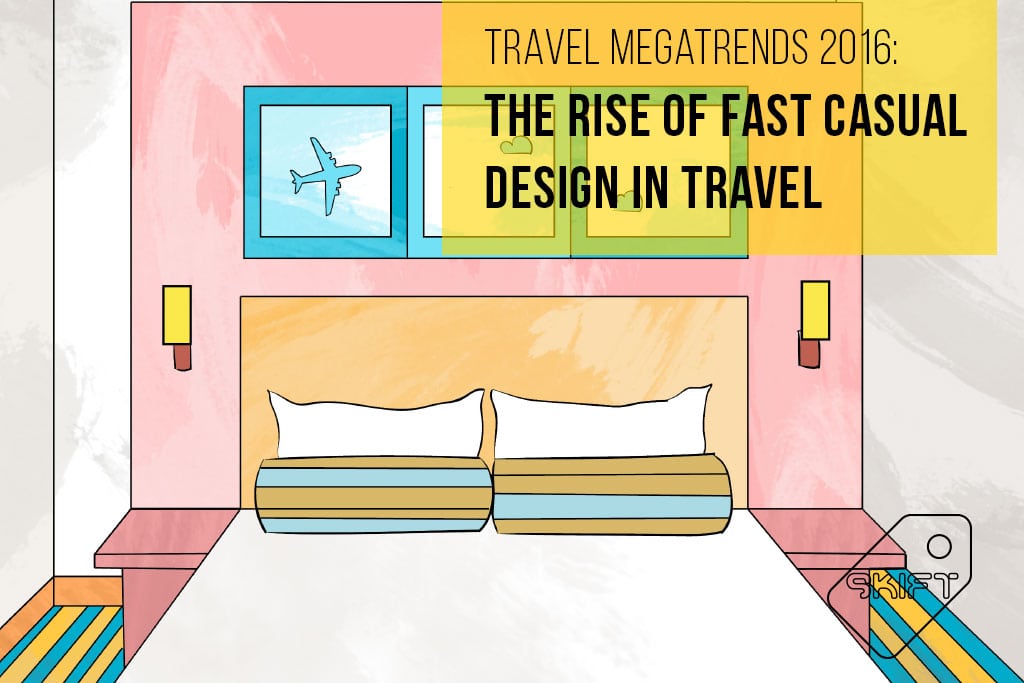Skift Take
Consumers like the simplicity of à la carte and only paying for the things that demonstrate clear value. Let’s get rid of the clutter.
In January we launched our annual package, Megatrends Defining Travel in 2016, where we identified the global trends in travel in 2016 and beyond.
For this trend, we looked at the influence of a dominant trend in retail and fast food and how it is shaping the way consumers think about design and service in the travel ecosystem.
Focus on the Basics
At the Element Harrison hotel outside of Newark Airport, the free breakfast queue snakes through the lobby in a sleep-deprived conga line.
Mini-quiches, bagels and cereals cascade across a cool tiled wall and guests ratchet through in self-service, stacking their plates high with simple, warm food. It’s an efficient and yet appealing way to feed an army of hotel guests in a style that’s quickly catching on within the travel industry: fast and casual.
The whole concept of fast and casual within the hospitality industry is a throwback to recent progress within the restaurant space. Chipotle, now famous for capturing market share from the legacy fast food brands, was able to resonate with younger customers by deconstructing the ordering process and dressing up the overall experience, making customers feel both classier and more in control of their purchases – all without breaking the bank. And now Shake Shack is one of the hottest purveyors of the fast casual concept, making it a brand restauranteurs around the world are copying.
Hotel brands like Element and Aloft, both Starwood properties, have now applied this model to the hotel space, using tools like self-serve meal kiosks and free Wi-Fi to appeal to a younger generation of travelers more sensitive to cost and less interested in the complexity and stuffiness of legacy brands.
“Fast casual seems to be a reaction to a decade of overdesign and superdesign,” says Lionel Ohayon, the CEO of Icrave, an innovation and design studio responsible for properties such as the Hotel Gan-sevoort Lobby in New York City and the C and D Delta terminals at LaGuardia Airport. “I think that there’s an elemental quality that people are now looking for in their travel experiences, something more spontaneous and participatory.”
Over at Marriott, the newest solution comes from Moxy hotels. Now open in Milan. Moxy’s design leans heavily on do-it-yourself meals, connected spaces and a communal lobby, shirking the tra-ditional hotel standbys of sit-down restaurants and concierges.
Do it yourself meals and pricing, or à la carte experiences, are also catching on in the airline space, where younger, cost-conscious travelers can choose the perks they want to pay for, ranging from checked bags to upgrades to frequent flyer miles. This is why budget carriers like Ryanair and Spirit have always done well with younger travelers – and why dinosaurs like Delta are now exploring ultra-barebones fares.
Looking forward into 2016, the concept of fast ca-sual in design will continue to rise, creating simple and cleaner experiences across the spectrum of user touch points. Travel providers will benefit by creating more efficient products that are less expensive to operate and that can be portioned out piecemeal for extra revenue. Consumers will benefit too, through cleaner user experiences and simpler, easier to understand fare and product structures.
In the end, everyone will come out a bit more efficient – and hopefully a bit happier too.
The Daily Newsletter
Our daily coverage of the global travel industry. Written by editors and analysts from across Skift’s brands.
Have a confidential tip for Skift? Get in touch
Tags: megatrends
